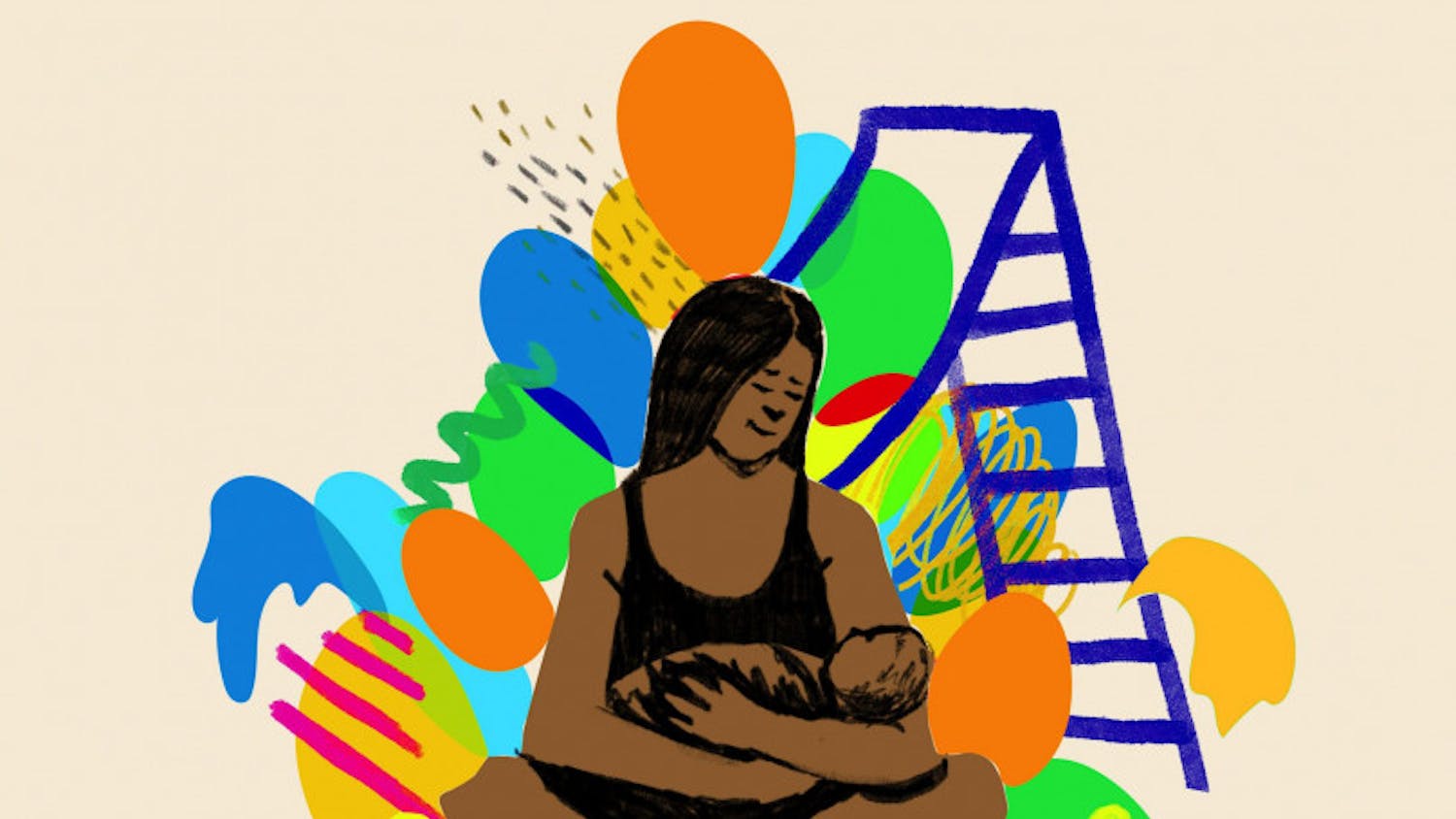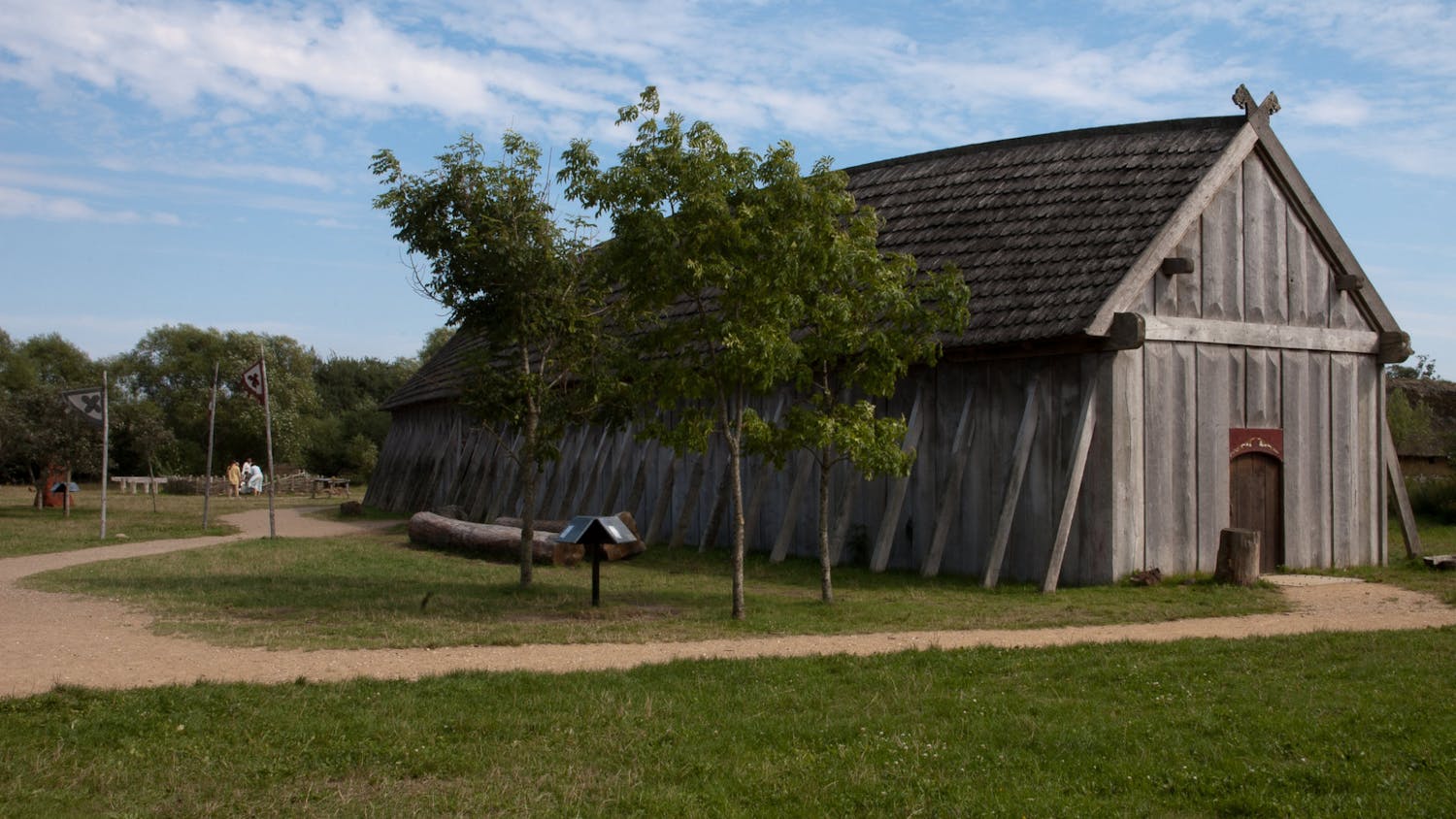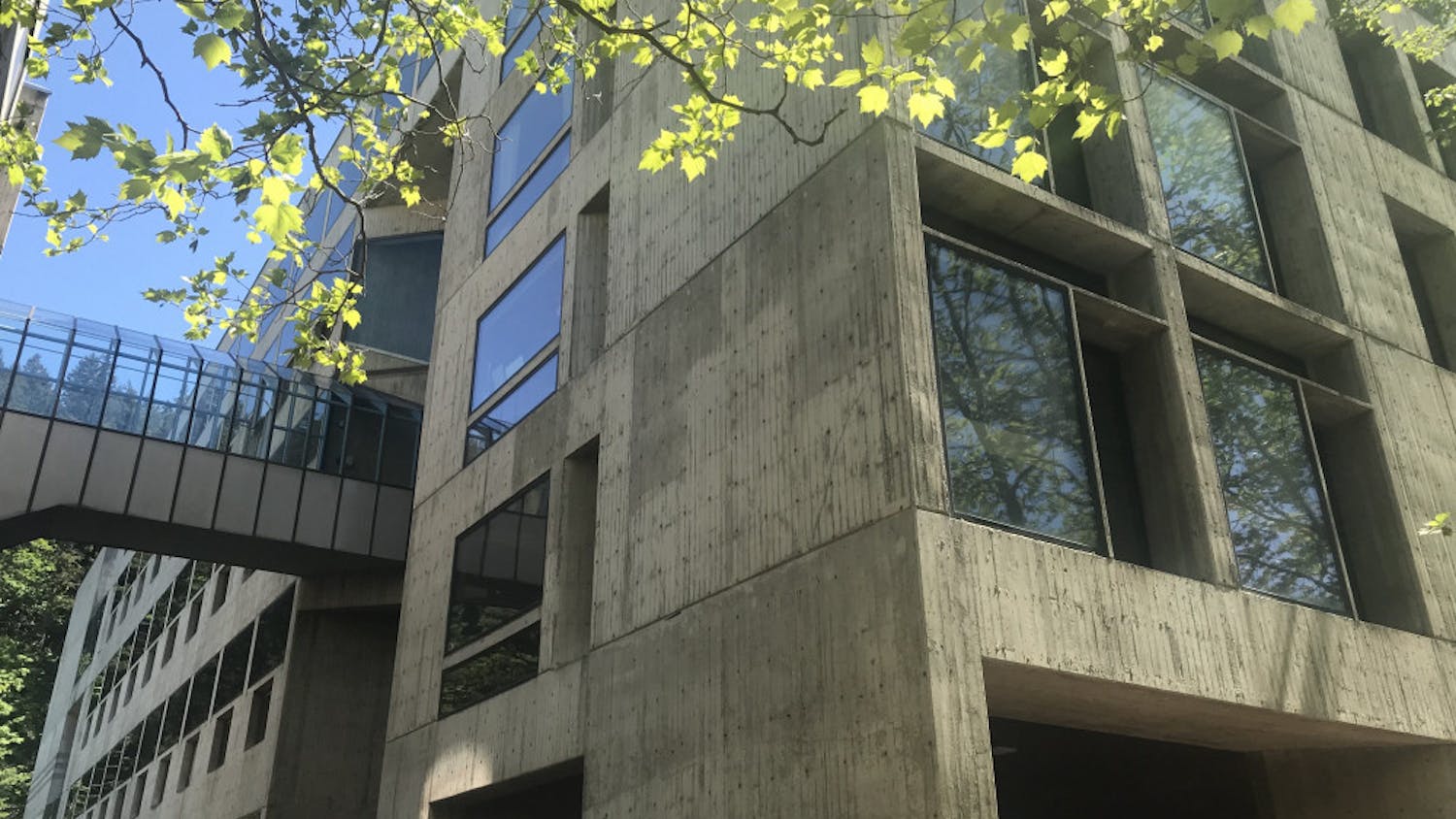Kamalla Kaur is the executive director of the Chardi Kala Project, which bridges between Sikhs and non-Sikhs, fighting hate crimes through education. “Chardi Kala” means to keep our spirits uplifted, particularly in tough times, by Grace. The Chardi Kala Project takes Sikh volunteers into schools and colleges to educate students about Sikhs and Sikhi. The Chardi Kala Project presents for Bellingham Parks and Recreation and the Whatcom County Library system and Chardi Kala Project volunteers sit booths at fairs, host field trips to local Gurdwaras (Sikh temples) for classes and clubs. They produce Interfaith events and feed the hungry.
Saint Joe’s Hospital on the Hill
I was born in 1955 at old St. Joseph’s Hospital at Forest and Beech Street, right below the Western Washington University campus in Bellingham. My family lived at 416 N. Forest, across from the old Spanish villa house.
My father was a professor at Western, which was then known as Western Washington State College. My mom tutored kids in our home until I reached second grade in 1962 when she started teaching full-time for the Bellingham School District. Bellingham had about 36,000 people back then, which included the several thousand students at the college.
The hospital building got turned into apartments years ago now, but when I was a child, I thought it was very reasonable to have a hospital at the end of my block.
Pacific Northwest children were tree climbers; we fell out of trees, we broke our bones and we needed stitches. The tune of the 1963 hit “Wipe Out!” by The Surfaris was often channeled as we biked down Cedar Street Hill — from Garden Street to State Street — and we would shout the titular phrase, “Wipe Out!” when accidents happened. In the winter we would sled down Cedar Street Hill and again shout, “Wipe Out!” I never skied, but of course, many Bellingham children did, and they broke their arms and legs. We got the measles and mumps back then, and the chickenpox too.
Our doctor, Dr. Jim, used to say that it wasn’t spring until my older brother, Bruce, got stitches. So when these childhood accidents happened, Dr. Jim could just meet us at St. Joe’s hospital. Otherwise, he did house calls. All the family doctors did house calls.
Another potential trip to our neighborhood hospital involved the playground equipment at Cedar Street playground at Forest and Cedar Street.
Everything was metal back then. From the perspective of a three or four-year-old, the stairs on the slide reached the sky. Kids rubbed the slide down with wax paper, so it was not only steep but fast! You shot out the bottom like a bullet — don’t “Wipe out!” You could swing ever so high on the tall metal swing-set and leap out, flying and then land — or “Wipe out!” And then there was the cold metal merry-go-round.
Brave kids would run around the outside pushing it to great speeds and then jump on. I would cling to the middle and try not to throw up. Getting tossed under that machine ended you up at our handy neighborhood hospital. This happened enough that the merry-go-round got removed from the playground by the city. This left a 5-foot-across mud hole that the city tried and failed to fix. Of course, the children kept stirring and opening the mud hole up. It was easy work because that mud hole was a force of nature. Actually, much of the year, most of Cedar Street playground was swampy. It probably still is.
Many baseball games were played at Cedar Street playground. I remember sitting quietly in the sandbox while the older kids and a few parents played baseball at the other end of the park. I didn’t notice a home run ball coming my way. It hit me right in the head.
“That will knock some sense into you,” my grandma Ida used to tell us anytime we fell on our heads or got hit with fly balls. That time I didn’t have to meet Dr. Jim at our neighborhood hospital, but I got watched for a couple of days for signs of concussion. It was nice to know the hospital was right there, if needed.
Another great feature of our neighborhood was the Armory at the bottom of Cedar Street Hill, on State Street. It was Bellingham’s roller rink. Roller rinks and drive-in movies should be brought back. Great, inexpensive, all-age entertainment. Anyway, I broke my arm roller skating when I was 7 years old and Dr. Jim met my parents and me at St. Joe’s Hospital and I got a cast on my arm, which my friends decorated with colored ballpoint pens.
Kids and Dogs
There were no leash laws when I was a child and almost every family had a dog. Dogs had the run of the neighborhoods, and the Western campus too. Dogs and kids were sent outside to play as much as possible by our moms, no matter the weather. We had to be home for dinner. No hanging around in the house. No adult supervision.
By today’s standards, Bellingham children were a bit feral. We played in Western’s Arboretum and in the woods at the north end of Highland Drive before they developed it. Children and dogs altogether.
By age 9, my brother was riding his bike all over town with his dog running alongside. I took the bus downtown, or across town to a friend’s house, with my parent’s permission. I was more into our cats.
But the first dog of my life, my dog nanny — like in the Disney movie, “Peter Pan” — named Leo, was special. He was a huge Boxer, unusually large. Leo had his daily neighborhood rounds. Every morning he visited the back doors of all the houses for a bit of communion and a treat. He was a noble, calm soul who generated great respect.
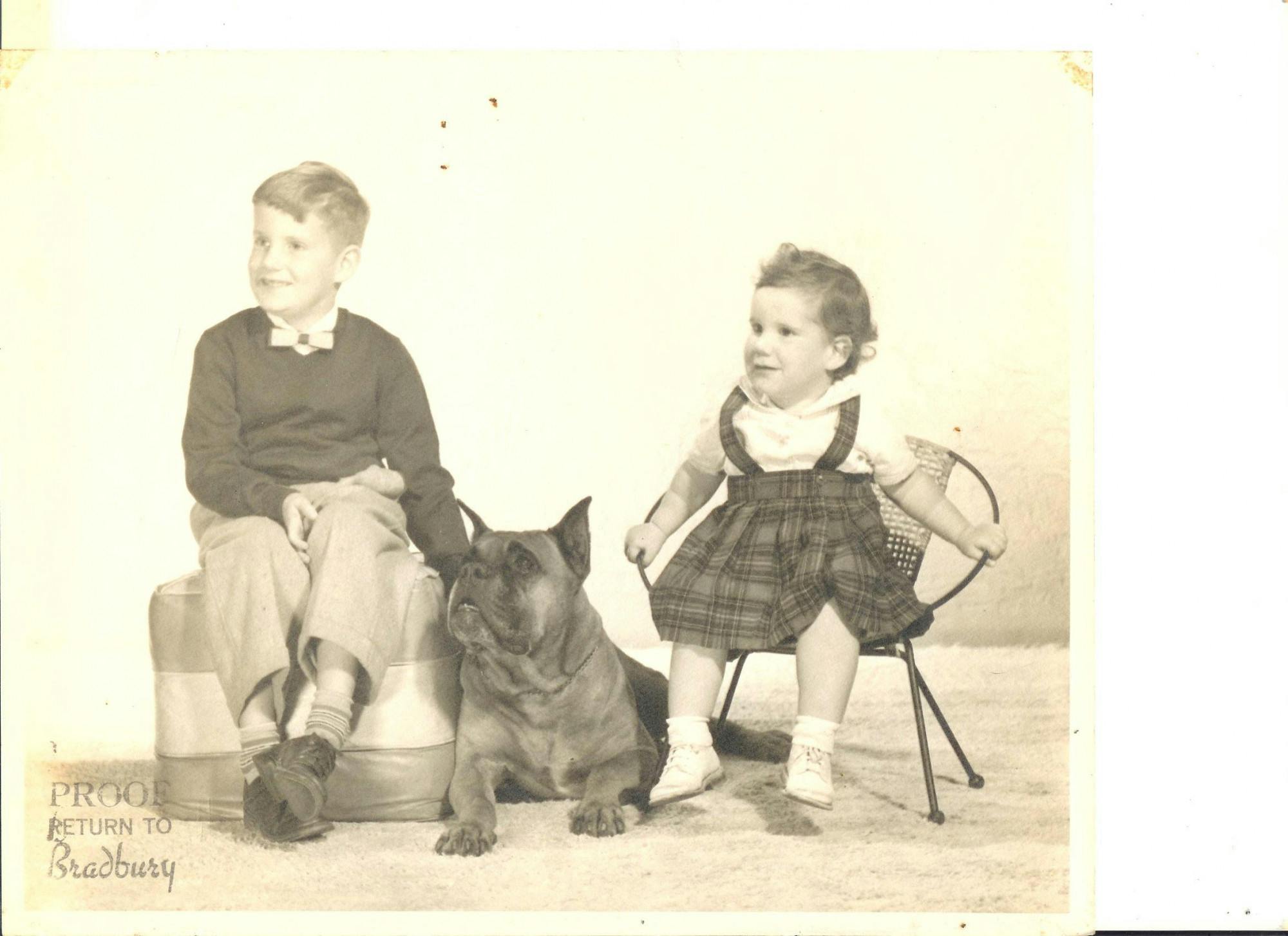
A photograph (left to right) of Kaur's older brother, Bruce at age 6, Kaur's dog, Leo, and Kaur, age 2, in 1957. Kaur and her family lived on Forest Street in Bellingham Wash., right below Western's campus. // Courtesy of Kamalla Kaur
The mothers on Forest Street trusted Leo. Forest Street had very little traffic. Leo would lie down across the middle of the street. This allowed kids to play in the street. When a car was on its way, Leo would stand up, stretch and wander over to the relevant lane. He would then take his stance facing down the oncoming vehicle. This was our cue to get out of the street. When Leo was sure all the kids were safe, he'd let the car through. Then he'd settle back down to sleep in the middle of the road and we'd go back to playing in the street.
Leo had a special thing for asparagus. My mother would lay cooked asparagus across Leo’s bowl of dog chow. Leo would carefully, with his big jowly lips, remove the asparagus one at a time and set them aside — all with great grace and appreciation. Then he would eat his chow. Then, for dessert, Leo would lie down and take one asparagus at a time between his floppy lips, and he would daintily sip it up. This was a neighborhood kid attraction, watching Leo blissfully sip up his asparagus.
Leo died in 1960 when I was 5. I had the measles at the time — very sick and then sick with grief. It was my first big death experience.
Life in Bellingham
Have I mentioned that everyone in Bellingham was racially white? Unbeknownst to innocent children, people of color had been evicted from town, repeatedly, down through white folk’s short history here. In 1855, we put the Lummi Nation on the reservation and we kicked the Chinese out of town. In 1907, the Sikhs. During World War II, we sent our Japanese neighbors to internment camps. Bellingham was also a sundown town where our police didn’t allow anyone of color to spend the night. This practice continued until the mid-1960s.
The late Dr. Bob Monahan told me that it was coach Bill McDonald, from Western Washington State College, who finally stopped the police from evicting people of color every night. According to Bob, the Coach got called down to the police station by one of Western’s foreign exchange students from Africa. The police were ready to escort the student out of town. Bob told me that coach McDonald yelled at the police, loud and hard, football coach style, telling them to stop the practice immediately. It seemed to have worked.
Meanwhile, our milk was delivered in glass bottles left on our front porch. The newspaper got thrown at our front doors early each morning by a kid on a bike.
We had this little wooden telephone table with a black telephone on it that weighed close to 10 pounds. It had a big receiver that sat, when not in use, in the cradle on top of the phone’s base, and a thick, black, curly cord connecting the base and receiver.
There were wires to the wall, out to the telephone poles. There were lots of telephone poles back then. The heavy silver rotary phone dial was endless fun. It clicked so nicely as it circled back to its home spot. Our phone had a party line for a while, but my mom hated it, so my parents paid the higher bill for a private line. Long-distance calls were pricey, so they were kept special and they were kept short.
Our family-owned a couple of appliances that could go berserk on us. One was the floor waxer and polisher — a motor with two spinning disks attached to it — for waxing and then buffing the hardwood floors. It had a metal handle similar to a push mower. Worked great if you dominated it, but it fought back, jerking this way and that in the hands of small or timid or weak people. And if you let go of the handle? If you let it jerk away from you, out of your control? Then that machine would take off dancing wildly around the room.
Likewise, I remember the very first dishwasher in our family. It wasn’t built-in, rather it was this big box that wheeled around the kitchen, with a handy cutting board on top. To run it you would hook the hose up to the kitchen sink faucet, which had a special spigot for the purpose.
The dishwasher worked pretty well too. But sometimes, mid-cycle, when the pressure inside the box was at peak and the water at its hottest, the dishwasher hose would pop off the special faucet spigot and fly around, spraying suds and hot water everywhere.
The way to calm these out-of-control appliances was to unplug them, except that there were never enough outlets in most houses, so each outlet had way too much stuff plugged into it, and there were no circuit breakers, just fuses, so our power went out a lot.
Our family was late in getting a television — not until 1960, when I was 5. It was black and white, with a rabbit ear antenna on top that you had to wiggle just right to get the machine to work. My folks put our TV on a cart so we could wheel it between rooms.
We picked up three stations pretty well, KVOS-12 here in Bellingham and two Vancouver stations. After school, there were endless “Popeye” cartoons and “The Three Stooges,” and then a really bad B-movie — like a cowboy movie, or an African explorer movie — completely racist crap. The news came next with the war in Vietnam, broadcast pretty much live into our homes.
Lots of ironing back then. And I had to sleep with tight, spikey curlers in my hair, which in hindsight seems like child abuse. Girls wore dresses to school, when shopping and to church.
When we got home we changed into play clothes — pants or shorts, with tops. My brother's chores were to feed the dog and mow the grass. My chores were way more than that. Not fair.
The newspaper had two separate job sections, one for men's jobs and one for women's jobs. The women's jobs section was small and jobs for women were scarce — waitress, receptionist and go-go dancer. Even the bank tellers were all men back then.
Everyone bought groceries at neighborhood stores. These stores had huge displays of penny candy, so kids visited them often. Most families, I believe, had accounts with the neighborhood stores that they paid off monthly. Visit Nelson’s Market in the York neighborhood for the experience of what neighborhood stores were like before the supermarkets opened.
We bought produce at Joe’s Garden, meat from the butcher shop and fish market, and people bought stuff from door-to-door salespeople. Citizens here worked to keep Bellingham a secret from the rest of the country. My parents always invited friends from out of state to visit in the very rainy month of “June-uary” so our visitors wouldn’t want to move here. There was fear about the “Los Angelizing” of the Salish Sea ecosystem. And there was a protest about the “Californication” of Bellingham as soon as it started to happen. Developments with dull architecture, shoddy building materials and houses painted every shade of mushroom — built quickly, all for a fast buck. A crying shame.
Campus School
Most of the children on my block attended elementary school up on Western's campus. It was called “Campus School,” now Miller Hall. We had an extremely enriched childhood, an unusual childhood, a fantastic childhood raised on the campus of Western Washington State College.
Western started out as a teacher’s college — a women’s normal school — and Campus School was their laboratory for 68 years. After World War ll there was an infusion of young academics, fresh from the fight against world fascism, who arrived at Western Washington State College.
They had a core fraternal belief in liberal arts (and science) education, believing that the way to fight fascism and racism was through education. They were men, and a few strong women professors, out to prove that if you give a young person as broad a curriculum as possible, if you teach her how to learn and how to always keep learning, if you encourage her to take her time before she "specializes" in anything, then no matter how many new skills and yet undreamed of jobs are needed in the future, she will be able to cope. She will have a full toolset, and a grasp of the big picture. Western was not a vocational school and had no corporate partners. Most students didn’t decide on a major until their senior years.
Teachers at Campus School were working at multiple levels. First and foremost, they were elementary school teachers, but some of them also taught college classes, and all of them had four to six student teachers to train up. Our class size was kept around 25 students. Divide that by four — or more — student teachers, add in our real teacher, and we are talking four or five students per teacher.
But that was only part of the wonder of Campus School. When Campus School teachers needed even more substitute teachers, or when they simply wished to give us access to Western's facilities, there were college professors who were genuinely eager to teach second graders for an afternoon. Swimming lessons at the old gym, time on the potter's wheel over at the art building, guided tours of the pipe organ, nature hikes on Sehome Hill and abundant musical concerts were all in a week’s work for us, thanks to the commitment of college professors, from all disciplines, to the Campus School experiment.
There were always observers in our Campus School classes. Parents, professors, students, visitors to the college, were welcome to sit in the back of the room and watch us. We kids were used to it. And our Campus School teachers always had strong lesson plans because they had an adult audience there. Not that they minded when we students surprised them with our insights and/or took their plans south.
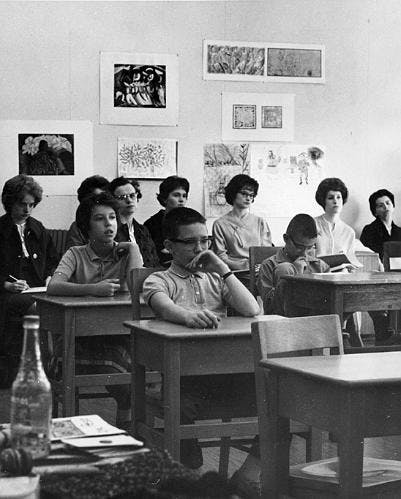
A photograph from Western Washington University archives shows a classroom of students being observed at the Campus School, which is now Miller Hall, in 1963. // Courtesy of Western Libraries’ Klipsun Yearbook Collection
Until I entered Fairhaven Middle School in 1966, I had never experienced a teacher who wasn’t thrilled to be out-smarted, up-staged or intellectually confronted by a student.
For instance, the story goes that my brother was in first grade when he blew up Mrs. Evelyn Hinds’ music class plans. Mrs. Hinds taught in the music department at Western and also at Campus School. That day she brought in a record player on a cart, and she had different classical albums with her. Her lesson plan was to have the first graders listen to various excerpts of classical music, and then share together how it made them feel, or describe the imaginary pictures the music invoked.
However, my brother started waving his hand as soon as Mrs. Hinds dropped the needle on the first vinyl record.
“Yes, Bruce?” Mrs. Hinds stopped the music to ask, “What do you want?”
“That’s Mozart, ‘Eine Kleine Nachtmusik,’ first movement!” Bruce declared, happily figuring he has won the “Name That Tune” contest. Mrs. Hinds talked about that class happily for years!
By the time my brother was 6, my father had trained him. Bruce could recognize any Western composer, usually be able to name the piece and the movement and often the opus number. It was a game with them, “Drop the Needle.”
Up on Western’s campus, there was more racial diversity with quite a few students from foreign lands. The first Black kids, arriving with their families in Bellingham in the early to mid-1960s, were sent to Campus School to protect them from a potentially hostile community. Did you know that Western had one of the first Ethnic Studies Colleges anywhere? It was a very big deal. It didn’t last. Funds got cut, students of color didn’t enjoy living in Bellingham, and according to the late Western president, Dr. Charles Jerry Flora, there were racists working on campus.
Red Square replaced our Campus School soccer field, which was a soggy grass wetland. When I started kindergarten, Haggard Hall was brand-new, with all sorts of wonderful displays to visit. The humanities building was built when I was in second grade. Because the land was swampy, they used a pile driver to construct it. This inspired one of my first poems which went something like:
“Boom! Hiss!”
By the young Kamalla
Boom! Hiss!
Boom! Hiss!
Boom Hiss!
Will it ever stop?
Boom! Hiss!
Boom! Hiss!
Boom! Hiss!
Bond Hall, on Red Square at Western, was constructed in 1967 to house a huge IBM mainframe computer in its basement. That computer was as big as a semitruck.
They closed Campus School the year after I left for Fairhaven Middle School, in 1967. And again, in 1968, they bricked the swampy Campus School playfield over with very bright red bricks. They have faded to terracotta over the decades since, but they were very red at first. So everyone spontaneously called it “Red Square,” like in Russia.
Then the administration named the fountain there, “Fisher Fountain,” after the Western president who was kicked out of his position by the Klu Klux Klan in the 1930s. President Charles Fisher was accused of being communist. So the installation of "Fisher Fountain" in "Red Square" was radical even for 1968. On campus, at least, it was a big joke.I think the goal at Campus School was to see if elementary school students could achieve a superior community college-level education by age 12. The answer was, “Yes!”
Automobiles Before Seat Belts
We had a Ford station wagon, a basic family car. There were bench seats front and back. When the whole family was out for a drive, my brother stood behind my father, who was driving, and I stood behind my mom. But since my parents chain-smoked with the windows closed, I soon wilted into a carsick blob on the floor.
A drive around the county, often a Sunday drive, was standard family entertainment. When there were just three of us in the car, we all piled onto the front bench seat, again with no seat belts. The car had a little gear stick that stuck out of the right side of the steering wheel console.
When driving around town, our father would let Bruce shift car gears while Dad worked the clutch with his foot. Later my father taught me as well, so we had the concept and feel of driving a manual transmission by the time we were 5 or 6.
Our father, not usually a risk-taker, enjoyed driving to the top of Toad Lake Road or Alabama Hill, and if nobody else was on the road, he would put the car in neutral and we would fly down those hills without using the brakes. We called this “car sledding.” Under where the pedestrian trellis is now on Alabama Hill, the road flattened, and there was a bump. When we hit that bump, we would launch into the air a bit.
The other sort of “car sledding” was a spectator sport: watching cars slide down Cedar Street Hill sideways when it was snowy. It snowed every winter back then and the snow stuck, and the town was white for weeks at a time. Alabama Hill was probably the most popular — and scary — sled run in town.
I am told the older kids cruised around and around in their cars — down Railroad Avenue up Cornwall and they circled through Cornwall Park. You used to be able to drive in one end of Cornwall Park and loop through it, and come out the other end. So it was a very social park.
Older kids had lots of keggers back then, as they do now. There were many party houses and Clayton Beach was a popular kegger site. However, Bellingham wasn't jacked up on espresso, and there were many taverns, not lots of breweries. Of course, commercial grow rooms and marijuana stores were beyond anyone’s imagination before the cultural revolution of the 60’s and pretty unimaginable after as well. Pot was so illegal.
But what does that have to do with cars and the lack of seat belts? I can't recall. Time to stop the old lady babblings. It has been a pleasure sharing with you a few of my memories of childhood in Bellingham, Washington in the 1960s. I predict that in a few decades the stories you tell of your youth will seem much stranger than mine. Change, it appears to me, is accelerating dramatically.
Have something to say? Send guest columns to The Front by emailing our opinions editor at westernfront.opeditor@gmail.com.



